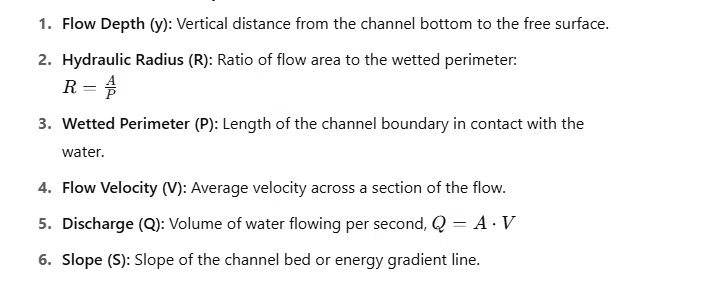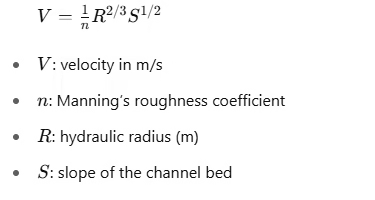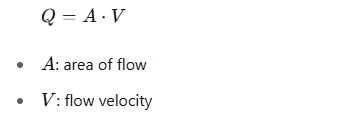📅 Updated on: July 31, 2025
👷♂️ Useful for: JKSSB JE Civil, SSC JE, RRB JE, AE Exams
📚 Subject: Fluid Mechanics – Civil Engineering
📌 Introduction to Open Channel Flow
Open Channel Flow refers to the movement of fluid, typically water, in a conduit or channel with a free surface exposed to atmospheric pressure. This free surface allows for the direct interaction of the fluid with atmospheric conditions, which significantly influences the behavior of the flow. Unlike pipe flow where pressure differences primarily drive the movement, open channel flow is governed mainly by gravity and the slope of the channel bed. The velocity and depth of flow can vary significantly depending on the channel’s shape, roughness, slope, and boundary conditions.
The analysis of open channel flow is crucial in civil engineering due to its extensive presence in natural and engineered environments. It plays a vital role in flood forecasting, river hydraulics, stormwater management, and the design of irrigation and drainage systems.
Examples of open channel flow include:
- Natural streams, creeks, and rivers with varying widths and slopes
- Man-made canals and lined irrigation ditches with uniform geometry
- Sewer lines that are only partially filled
- Urban stormwater drainage systems and open gutters
- Hydraulic structures such as culverts, spillways, and flumes
Understanding the principles of open channel flow aids engineers in predicting water levels, designing channel sections for efficient flow, and ensuring safe and sustainable water management practices.
- Natural streams and rivers
- Man-made canals and irrigation ditches
- Sewer lines (partially full)
- Stormwater drains
- Culverts and spillways
Understanding open channel flow is crucial for civil engineers involved in hydraulic engineering, irrigation, drainage systems, and flood control.
🧠 Basic Terms in Open Channel Flow

🌐 Classification of Open Channel Flow
Open channel flow can be classified in several ways:
🔸 1. Based on Time Variation:
- Steady Flow: Flow parameters (velocity, depth, discharge) do not change with time at any section.
- Unsteady Flow: Flow parameters change with time.
🔸 2. Based on Space Variation:
- Uniform Flow: Depth and velocity remain constant along the channel length.
- Non-uniform Flow: Depth and velocity vary along the channel.
🔸 3. Based on Depth Variation:
- Gradually Varied Flow (GVF): Flow depth changes slowly and smoothly along the length.
- Rapidly Varied Flow (RVF): Abrupt changes in depth, e.g., hydraulic jump.
🔸 4. Based on Froude Number (Fr):

🔍 Flow Regimes and Their Importance
Understanding the flow regime (subcritical, critical, supercritical) helps in designing stable channels. For instance:
- Subcritical flows require attention to downstream conditions because disturbances or changes in the downstream water surface elevation can propagate upstream and influence the flow conditions. In this regime, the gravitational forces dominate over inertial forces, causing the flow to be stable but sensitive to changes downstream. For example, if a gate is closed or a dam structure is introduced at the downstream end, it can significantly affect the upstream water levels. Therefore, in designing open channels operating under subcritical conditions, it is essential to analyze the downstream boundary conditions to ensure smooth and efficient flow.
- Supercritical flows are governed by upstream changes because in this regime, the inertial forces dominate over gravitational forces. This means that the flow is fast-moving and relatively shallow, and any disturbance or change introduced upstream affects the downstream flow characteristics, but not vice versa. For example, if the slope or roughness of the channel changes at an upstream location, it can significantly influence the velocity and depth of flow downstream. These flows are less stable, more prone to erosion, and require careful energy dissipation measures downstream. Therefore, in designing channels expected to carry supercritical flow, engineers must focus on upstream hydraulic conditions and ensure proper control structures to manage flow transitions.
- Hydraulic jumps occur when supercritical flow transitions to subcritical flow, resulting in a sudden increase in flow depth and a significant loss of kinetic energy. This transition typically happens in open channels when a high-velocity, low-depth flow (supercritical) encounters a zone of lower velocity and higher depth (subcritical), causing turbulence, surface rollers, and energy dissipation. Hydraulic jumps are commonly observed downstream of spillways, sluice gates, and weirs. They are used in engineering applications to reduce the erosive power of flowing water and to stabilize downstream flow. The energy lost during a hydraulic jump is transformed into turbulence and heat, which helps protect channel beds and structures from damage.
🧮 Important Equations in Open Channel Flow
- Manning’s Formula:

- Chezy’s Equation:

- Continuity Equation:

📐 Cross Sections of Channels
- Rectangular: Simple shape used in labs and some concrete channels
- Trapezoidal: Common in irrigation canals
- Circular: Common in sewer systems
- Parabolic: Sometimes used in urban drainage for self-cleaning properties
🏞️ Real-World Applications
- Irrigation Design: Properly sized channels ensure efficient water delivery.
- Urban Drainage: Manage stormwater during peak rains.
- River Engineering: Study of flow profiles and flood forecasting.
- Energy Dissipation: Use of hydraulic jumps to reduce energy in spillways.
🧪 Example Problem for JKSSB Exam
Q: A trapezoidal channel has a bottom width of 4 m, side slope 1:1, and flow depth of 2 m. Calculate the cross-sectional area.

📚 Tips to Master Open Channel Flow for JKSSB JE
- Revise formulas regularly (especially Manning’s & Froude number)
- Understand types of flows through visuals or videos
- Practice problems from GATE, SSC JE, and previous JKSSB exams
- Prepare short notes with classification tables and diagrams
📌 Conclusion
Open channel flow is a foundational aspect of civil engineering, vital for the design and operation of hydraulic structures and water conveyance systems. It has broad applications in fields such as irrigation planning, stormwater drainage, urban hydrology, river engineering, and environmental management. Professionals in these fields must understand how water behaves under various open flow conditions to ensure system efficiency, safety, and sustainability.
For JKSSB aspirants and other competitive exam candidates, open channel flow forms a significant part of the fluid mechanics syllabus. Mastering this topic ensures comprehensive preparedness not only for theory-based questions but also for practical numericals and case-based scenarios often asked in exams. Essential concepts such as Froude number, Manning’s equation, hydraulic radius, and classifications of flow must be internalized thoroughly. A solid understanding allows candidates to tackle questions with confidence, especially those related to flow regimes, hydraulic jumps, and energy losses.
📌 Join our Telegram Channel JKSSB CivilsCentral for regular updates, quizzes, PDF notes, and practice sets curated specifically for JKSSB aspirants.


